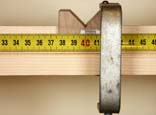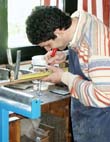N E W 5 - O C T A V E H A R P S I C H O R D S
I N T H E N E A P O L I T A N S T Y L E
Making the measuring and marking-out sticks
These instruments are built, not using full-scale drawings, but using a series of three measuring sticks. One stick is used to mark out the simple baseboard dimensions, wrestplank position, register gap, keywell, etc, a second and third to mark out the string lengths and plucking points in conjunction with a stick marking out the lateral string spacing. A third stick is used to mark the layout of the keyboard. This page outlines how we made these marking out sticks to construct the instruments with an extremely high degree of accuracy and precision.
The instruments were made using only a sketch drawing indicating the various dimensions and measurements in Neapolitan once. A ruler was made marked out in once and each oncia on the ruler was divided into 10 minuti. Then a series of sticks was made as descrbed above giving: 1) the various case dimensions, 2) the string lengths of each of the f notes and the lengths of the notes at the breaks at the bass end of the bridges, as well as the plucking points of the bottom F1, f and f3 notes, and 3) the lateral spacing of the pins on the bridge and the nut.
These stick were made from a long batten of sycamore wood of standard cross section which fitted accurately into our walnut cutting block made especially for this purpose. A series of 'V'-shaped notches was made in each stick, and these notches were used to position a sharp scribing awl during the marking-out process.
This section shows how the sticks were measured out and made in such a way that the notches were positioned with an accuracy of 0.1mm.
Return to the main 'Mozart' harpsichord design section





